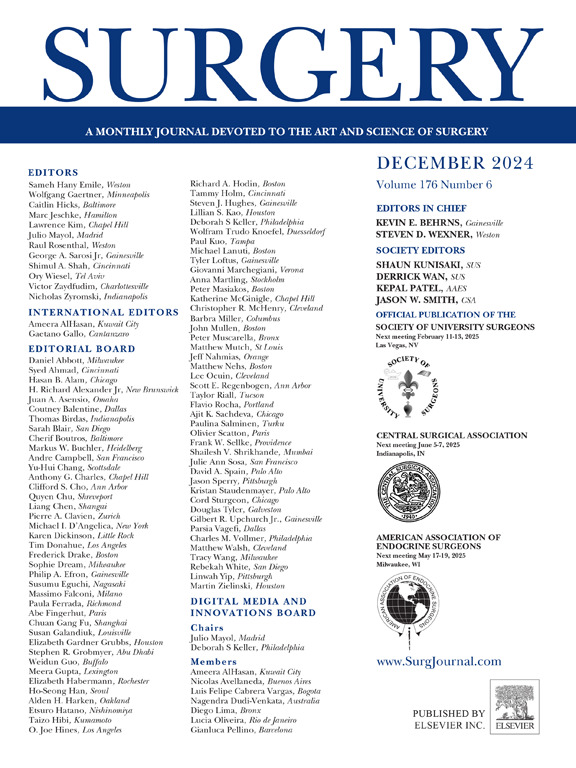Calcium phosphate deposition, tertiary hyperparathyroidism, and the long-term effect on kidney allografts
IF 3.2
2区 医学
Q1 SURGERY
引用次数: 0
Abstract
Background
Tertiary hyperparathyroidism adversely affects kidney allografts, with calcium phosphate deposition hypothesized to be an underlying cause. We analyzed allograft biopsies to investigate risk factors for calcium phosphate deposition and understand its impact on allograft function.
Methods
We reviewed patients who underwent kidney transplantation from 2017 to 2019. Tertiary hyperparathyroidism was defined as an elevated parathyroid hormone and hypercalcemia beyond 3 months’ posttransplant or being prescribed cinacalcet. Allograft failure was defined as needing dialysis posttransplantation or retransplantation beyond 3 months’ posttransplant. Three- and 12-month allograft biopsies were reviewed for calcium phosphate deposition. The χ2, t-test, and multivariate regression were used for statistical analysis.
Results
Of 159 patients who underwent kidney transplantation, 59 (37.1%) were diagnosed with tertiary hyperparathyroidism. Longer preoperative dialysis vintage (odds ratio, 1.47; confidence interval, 1.22–1.80 P < .001) and preoperative cinacalcet usage (odds ratio, 18.4; confidence interval, 7.24–53.0 P < .001) were associated with tertiary hyperparathyroidism. In total, 36 of 59 (61%) patients with tertiary hyperparathyroidism had calcium phosphate deposition on 3- or 12-month kidney allograft biopsy compared with 23 of 100 (23%) patients without tertiary hyperparathyroidism (P < .001). Tertiary hyperparathyroidism (odds ratio, 6.01; confidence interval, 2.91–13.0 P < .001) was associated with calcium phosphate deposition. Calcium phosphate deposition and tertiary hyperparathyroidism were not associated with worse glomerular filtration rate at 3 years’ posttransplantation. Of those with data available at 3 years’ posttransplantation, 21 of 49 (42.9%) patients remained on cinacalcet. There were 3 of 159 (2%) patients who had allograft failure, 2 of whom had both tertiary hyperparathyroidism and calcium phosphate deposition.
Conclusion
Preoperative variables associated with tertiary hyperparathyroidism included longer dialysis vintage and cinacalcet use. Tertiary hyperparathyroidism was the main risk factor for calcium phosphate deposition posttransplantation. In our population, calcium phosphate deposition and tertiary hyperparathyroidism were not significantly associated with lower glomerular filtration rate.
磷酸钙沉积、三级甲状旁腺功能亢进症以及对肾脏异体移植的长期影响。
背景:三级甲状旁腺功能亢进症会对肾脏异体移植物产生不利影响,而磷酸钙沉积被认为是其根本原因。我们分析了异体移植物活检组织,以调查磷酸钙沉积的风险因素,并了解其对异体移植物功能的影响:我们回顾了 2017 年至 2019 年接受肾移植的患者。三级甲状旁腺功能亢进定义为甲状旁腺激素升高和移植后超过3个月的高钙血症,或被处方西那卡塞。同种异体移植失败的定义是移植后需要透析或移植后3个月后再次移植。对3个月和12个月的异体移植活检进行复查,以检测磷酸钙沉积情况。采用χ2、t检验和多变量回归进行统计分析:结果:在159例接受肾移植的患者中,59例(37.1%)被诊断为三级甲状旁腺功能亢进。术前透析时间较长(几率比,1.47;置信区间,1.22-1.80 P < .001)和术前使用西那卡塞(几率比,18.4;置信区间,7.24-53.0 P < .001)与三级甲状旁腺功能亢进症有关。在59例三级甲状旁腺功能亢进症患者中,共有36例(61%)在3个月或12个月的肾移植活组织检查中出现磷酸钙沉积,而在100例三级甲状旁腺功能亢进症患者中,只有23例(23%)没有出现磷酸钙沉积(P < .001)。三级甲状旁腺功能亢进(几率比 6.01;置信区间 2.91-13.0 P < .001)与磷酸钙沉积有关。磷酸钙沉积和三级甲状旁腺功能亢进与移植后 3 年肾小球滤过率下降无关。在移植后 3 年有数据可查的患者中,49 人中有 21 人(42.9%)仍在服用西那卡塞。159例患者中有3例(2%)发生了异体移植失败,其中2例同时患有三级甲状旁腺功能亢进症和磷酸钙沉积症:结论:与三级甲状旁腺功能亢进症相关的术前变量包括透析时间较长和使用西那卡塞。三级甲状旁腺功能亢进是移植后磷酸钙沉积的主要风险因素。在我们的研究对象中,磷酸钙沉积和三级甲状旁腺功能亢进与肾小球滤过率降低无明显关系。
本文章由计算机程序翻译,如有差异,请以英文原文为准。
求助全文
约1分钟内获得全文
求助全文
来源期刊

Surgery
医学-外科
CiteScore
5.40
自引率
5.30%
发文量
687
审稿时长
64 days
期刊介绍:
For 66 years, Surgery has published practical, authoritative information about procedures, clinical advances, and major trends shaping general surgery. Each issue features original scientific contributions and clinical reports. Peer-reviewed articles cover topics in oncology, trauma, gastrointestinal, vascular, and transplantation surgery. The journal also publishes papers from the meetings of its sponsoring societies, the Society of University Surgeons, the Central Surgical Association, and the American Association of Endocrine Surgeons.
 求助内容:
求助内容: 应助结果提醒方式:
应助结果提醒方式:


